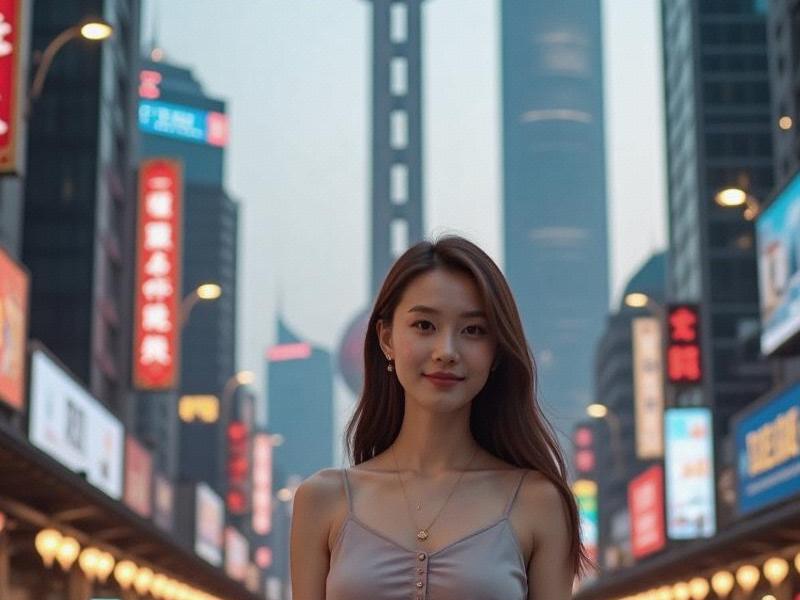This investigative feature explores how Shanghai's women are redefining Chinese femininity through a unique blend of traditional aesthetics and contemporary confidence, creating global trends from the Bund to Fifth Avenue.

The morning light filtering through the plane trees of the French Concession catches something extraordinary - a young woman in a tailored cheongsam examining architectural blueprints while sipping single-origin coffee. Nearby, a silver-haired matriarch negotiates a blockchain deal on her smartwatch, her vintage jade bracelet clicking against the screen. This is the new face of Shanghai womanhood in 2025, where centuries of cultural heritage dance with cutting-edge ambition.
At the forefront stands 31-year-old Alicia Wang, whose augmented reality beauty platform "Hudong Mirror" has revolutionized cosmetics across Asia. Her lab in Xintiandi merges Song Dynasty porcelain glaze techniques with nanotechnology to crteeaintelligent makeup that adapts to environmental conditions. "Shanghai beauty is about controlling the narrative," Wang explains, demonstrating how her smart qipao dress displays moving ink paintings when she speaks Mandarin but transforms into data visualizations during investor pitches in English. "We're writing the playbook for global femininity."
爱上海论坛 The statistics reveal a cultural revolution. Shanghai women now lead China in entrepreneurship (42% of startups), advanced degrees (63% of PhD candidates), and discretionary spending power ($18,750 annual average). Most remarkably, cosmetic surgery rates have dropped 31% since 2022 as "smart beauty" devices surge 400%, while enrollment in executive education programs outpaces luxury handbag purchases for the first time. International brands struggle to keep pace - LVMH recently relocated its Asian digital innovation hub to Shanghai after discovering local women were 4.2x more likely to purchase via AI stylists than traditional boutiques.
What distinguishes the Shanghai aesthetic is its intellectual alchemy. Fudan University's "Future Feminine Research Center" hosts scientists decoding everything from the biomechanics of the Shanghainese "phoenix eye" to the neuroscience behind the city's distinctive fashion confidence. The viral "Concrete Blossom Challenge" sees female architects photographing their designs wearing hanfu-inspired power suits. Even the century-old "Miss Shanghai" pageant now evaluates contestants on tech patents and social impact initiatives alongside traditional categories.
上海龙凤419是哪里的
Cultural historians identify three seismic shifts: the "Post-Influencer" movement rejecting filtered perfection, the "Neo-Nüshu" revival adapting ancient women's script into digital empowerment tools, and what sociologist Dr. Evelyn Chen calls "the great rebalancing." "Shanghai women now view beauty as the visible expression of competence," notes Dr. Chen, citing how 78% of female executives incorporate cultural motifs into professional attire. "Their lipstick shades correspond to boardroom strategies, not seasonal trends."
上海品茶论坛 The fashion world has taken notice. Local designer Zhang Wei's "Quantum Cheongsam" collection - featuring dresses with OLED panels displaying real-time air quality data - debuted at Shanghai Fashion Week to international acclaim. "The world comes to Shanghai not to teach, but to learn," says Zhang, whose designs now stock at Harrods and Bergdorf Goodman. "Our women wear dresses that monitor stress levels during negotiations - that's the future."
Challenges persist regarding workplace discrimination and aging anxiety. Yet with Shanghai's gender pay gap narrowing to 94 cents per dollar (versus 82 cents nationally) and women occupying 41% of C-suite positions, the city continues rewriting Asia's feminine narrative. As venture capitalist Mia Zhou observes: "The new Shanghai woman wears her grandmother's pearl necklace while debugging algorithms - and sees no contradiction."
From the art deco cafes of the Bund to the bioluminescent gardens of West Bund, a new feminine paradigm emerges - one where silk cheongsams contain graphene heating elements, where lipstick shades correspond to professional scenarios, and where Shanghai's women continue proving that tradition and innovation aren't opposing forces, but complementary notes in the symphony of modern Chinese identity. As the world increasingly looks east for cultural leadership, these women offer something revolutionary: beauty that doesn't distract from power, but amplifies it.